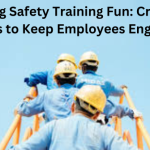Keeping employees safe should always be a top priority as their well-being directly affects the organization’s efficiency. Don’t treat safety as a secondary concern.
Instead, make it an essential part of your company’s culture. By prioritizing workplace safety, you can achieve higher productivity and create a healthier work environment for everyone.
What is workplace safety?
Workplace safety is essential for preventing harm, accidents, and negative outcomes in the workplace. It involves policies, behaviors, and precautions that limit hazards and protect employees’ well-being.
Why should one be aware about safety hazards at the workplace?
Nearly every career has risks, so it’s crucial for professionals and businesses to understand potential hazards and create a safety plan. To achieve this, companies perform hazard assessments of the work environment and equipment. Identifying risks can help establish a safe work environment.
What are workplace hazards?
Workplace hazards are risks specific to each industry or project, as per OSHA. These hazards can cause damage, harm, or adverse health effects on employees. For instance, those in construction and manufacturing may encounter machinery-related hazards, while landscapers face outdoor-related hazards.
Types of safety hazards
There are several types of workplace hazards that employees may encounter, including:
- Physical hazards: Physical hazards are environmental factors that can cause physical harm or injury to workers. These hazards can include noise, vibration, radiation, and extreme temperatures.
For example, exposure to high levels of noise or vibration can cause hearing loss or musculoskeletal disorders, and exposure to radiation can cause burns, cancer, or other health problems.
- Chemical hazards: Chemical hazards refer to exposure to toxic chemicals, gases, and liquids, which can lead to respiratory problems, skin irritation, and other adverse health effects. These chemicals can be found in various industries, such as manufacturing, healthcare, and agriculture.
Examples of chemical hazards include exposure to asbestos, lead, mercury, and pesticides.
- Biological hazards: Biological hazards involve exposure to bacteria, viruses, and other microorganisms, which can cause illnesses such as hepatitis, tuberculosis, and COVID-19. These hazards can be found in healthcare, agriculture, and food industries, among others. Workers may be exposed to biological hazards through contact with contaminated objects or fluids, infected animals, or other infected individuals.
- Ergonomic hazards: Ergonomic hazards result from poor ergonomic design, which can cause musculoskeletal disorders such as carpal tunnel syndrome, back pain, and other related injuries. Ergonomic hazards can be caused by repetitive motions, awkward postures, and excessive force. These hazards are often found in industries that require workers to perform manual labor or use tools and equipment for extended periods.
It is essential for employers to identify and address these hazards to ensure a safe and healthy work environment for their employees. This can be done through various methods, such as implementing safety protocols, providing training, and supplying personal protective equipment.
How can safety training help prevent workplace hazards?
Safety training is an essential tool for preventing workplace hazards.
Here are some ways that safety training can help prevent workplace hazards:
- Awareness: Safety training increases employees’ awareness of potential hazards in the workplace. By learning about different types of hazards, employees can identify potential hazards and take steps to prevent them.
- Prevention: Safety training provides employees with knowledge and skills to prevent accidents and injuries. For example, employees can learn proper techniques for using machinery, handling hazardous materials, and working at heights.
- Compliance: Safety training can help ensure compliance with safety regulations and standards. This is especially important in industries where regulatory bodies like OSHA (Occupational Safety and Health Administration) have set specific rules and requirements.
- Culture: Safety training can help create a culture of safety in the workplace. When employees are trained to prioritize safety, they are more likely to take steps to prevent hazards and report any unsafe conditions.
- Confidence: Safety training can increase employees’ confidence in their ability to work safely. This can lead to improved job performance and reduced stress, which can have a positive impact on overall workplace morale.
Conclusion
Safety training is a crucial component of workplace safety. By providing employees with the knowledge and skills to prevent hazards, employers can create a safer work environment and reduce the risk of accidents and injuries.
STK (Safety Training Kiosk) helps you in taking a 360 approach to safety training which ensures that all the stakeholders are trained as per their risk exposure and based on the overall impact on risk mitigation plan.



